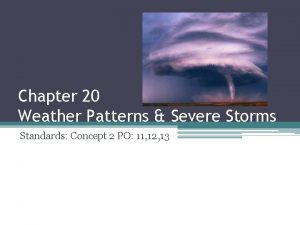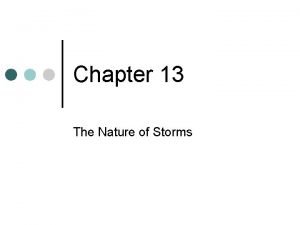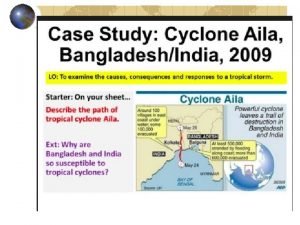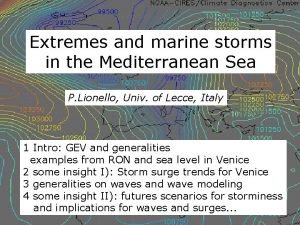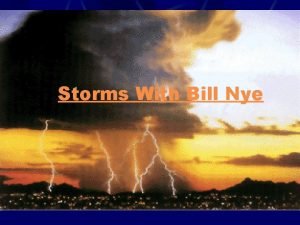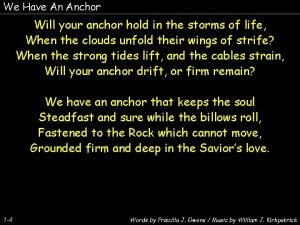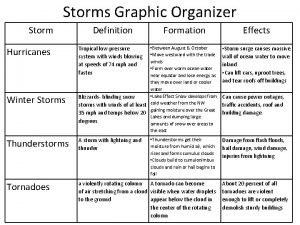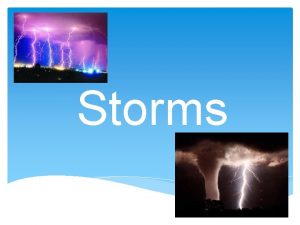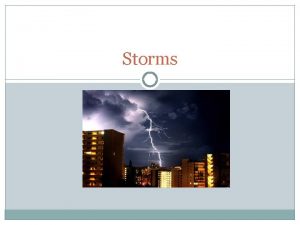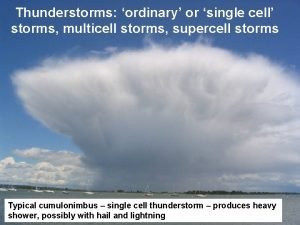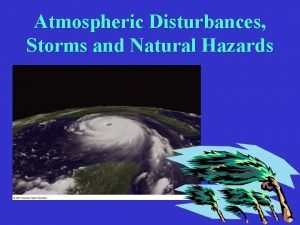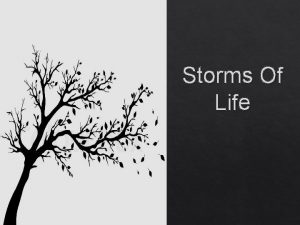Storms Chapter 4 Lesson 5 Storms Chapter 4










- Slides: 10

Storms Chapter 4 Lesson 5

Storms – Chapter 4 Lesson 5 Objectives 1. List the main kinds of storms and explain how they form. 2. Describe measures that can be taken to ensure safety in a storm. DCI-MS-ESS 3. B. 1 Mapping the history of natural hazards in a region, combined with an understanding of related geologic forces can help forecast the locations and likelihoods of future events. PE-MS-ESS 3 -2 Analyze and interpret data on natural hazards to forecast future catastrophic events and inform the development of technologies to mitigate their effects. DCI-MS-ESS 2. C. 4 The complex patterns of the changes and the movement of water in the atmosphere, determined by winds, landforms, and ocean temperatures and currents, are major determinants of local weather patterns. DCI-MS-ESS 2. D. 1 Weather and climate are influenced by interactions involving sunlight, the ocean, the atmosphere, ice, landforms, and living things. These interactions vary with latitude, altitude, and local and regional geography, all of which can affect oceanic and atm PE-MS-ESS 2 -5 Collect data to provide evidence for how the motions and complex interactions of air masses results in changes in weather conditions.

Planet Diary - The Blizzard of 1978 In February 1978, a huge blizzard hit the northeastern United States. Weather stations recorded hurricane-force winds, and many cities received record-breaking amounts of snow. The storm hovered over New England, and heavy snow fell for almost 33 hours without letting up. In Massachusetts, people driving on highways abandoned their cars when the snow became too deep to drive through. Rescuers used cross-country skis and snowmobiles to help evacuate the roads. Stranded drivers returned home any way they could. The governor of Massachusetts declared a state of emergency. He called in the National Guard to clear the roads of snow. It took almost a week until the roads opened again. What do you think made the blizzard so dangerous? Besides the hurricane-force winds and the roads filling with snow, what other hazards do you think the blizzard caused?

Severe Storms A storm is a violent disturbance in the atmosphere. Storms involve sudden changes in air pressure, which cause rapid air movements. There are several types of severe storms: winter storms, thunderstorms, hurricanes, and tornadoes.

Different Types of Storms A storm is a violent disturbance in the atmosphere. Storms involve sudden changes in air pressure, which cause rapid air movements. Winter storms, thunderstorms, hurricanes, and tornadoes are all types of severe storms. Winter Storms Winter storms involve snow. All year round, most precipitation begins in clouds as snow. If the air is colder than 0ºC all the way to the ground, the precipitation falls as snow.

Different Types of Storms Thunderstorms A thunderstorm is a small storm often accompanied by heavy precipitation and frequent thunder and lightning. Lightning is a sudden spark, or electrical discharge, that jumps between parts of a cloud, between nearby clouds, or between a cloud and the ground. Thunderstorms form in large cumulonimbus clouds, also known as thunderheads.

Different Types of Storms Hurricanes A hurricane is a tropical cyclone with winds of 119 km/h or higher. A hurricane begins over warm ocean water as a low-pressure area, or tropical disturbance. The low pressure and winds of a hurricane can cause storm surge, a “dome” of water that sweeps across the coast where the hurricane lands. Tornadoes A tornado is a rapidly whirling, funnel-shaped cloud that reaches down from a thunderstorm to touch Earth’s surface. Tornadoes most commonly develop in thick cumulonimbus clouds—the same clouds that bring thunderstorms.

Different Types of Storms Did You Know? A fulgurite forms when lightning strikes sand or sandy soil. The temperature of the lightning is so high that it melts the sand forms a tube made of glass. What is the most common type of severe storm in your area? Is there a type of severe storm that never occurs in your area?

How Can You Stay Safe in a Storm? If you are caught in a snowstorm, try to find shelter from the wind. If you are in a car, be sure the exhaust pipe is free of snow before you run the engine. During thunderstorms, avoid places where lightning may strike. Also, avoid objects that can conduct electricity, such as metal objects and bodies of water. In case of a hurricane, you should be prepared to evacuate, or move away temporarily. If you hear a hurricane warning and are told to evacuate, leave the area immediately. The safest place to be during a tornado is in a storm shelter or a basement. If there is no basement, move to the middle of the ground floor away from windows and doors.

 Chapter 20 weather patterns and severe storms
Chapter 20 weather patterns and severe storms Chapter 20 weather patterns and severe storms
Chapter 20 weather patterns and severe storms Chapter 13 the nature of storms
Chapter 13 the nature of storms Global distribution of tropical storms
Global distribution of tropical storms Amun ra symbols
Amun ra symbols Storms in the mediterranean sea
Storms in the mediterranean sea Egyptian god of storms
Egyptian god of storms Bill nye tornadoes
Bill nye tornadoes Jo storms
Jo storms Fastened to the rock which cannot move
Fastened to the rock which cannot move Winter storms definition
Winter storms definition

